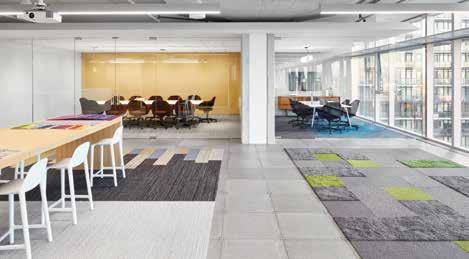
4 minute read
Taking Action - Why We Need to Design & Build With Carbon in Mind
Why We Need to Design and Build With Carbon in Mind
By Lisa Conway
Advertisement
In recent years, human-centered design and biophilic design have been key initiatives in commercial architecture. In the industry’s mission to consider both how individuals experience a space and the effect of materials within the space, a building's impact on climate change beyond operational energy became an afterthought in some cases.
Today, the building sector is the world’s single largest emitter of greenhouse gases (GHGs), accounting for nearly 40% of total global GHG emissions according to the International Energy Agency. Experts say that carbon emissions from the built environment must peak within the next 15 years for Earth to stay below the global warming tipping point. Architects and designers in Canada and across the globe have an opportunity to help curb emissions in the built environment by specifying products that promote green chemistry, a circular economy and a healthier climate across the billions of square metres of new buildings and major renovations worldwide.
Buildings produce two types of carbon emissions. The first is operational carbon, which is defined as the carbon dioxide emitted during the life of the building, such as the energy used for heating, cooling and lighting. The second is embodied carbon, which is the carbon dioxide emitted as building materials are manufactured, transported and constructed.
The Interface office in Toronto. Interface is working toward being a carbon negative company by 2040.


It’s crucial that we reduce both emission types, but reducing embodied or “upfront” carbon is the most urgent opportunity as it stands today. Knowing that, architecture and design firms have an immense opportunity to push climate change initiatives forward by proactively working to reduce embodied carbon.
Through carbon-action organizations, such as materialsCAN, as well as careful research and strategic material specification, we can create spaces that produce measurable benefits backed by science. In fact, those specifying and manufacturing products for the built environment have the opportunity to create a positive impact on the planet and the health of society at large. Here are four strategies to keep in mind that reduce embodied carbon:
• Reuse materials, material waste and buildings whenever possible to eliminate the need to create new materials and construction. The use of recycled content does more than simply divert waste materials from landfills. By replacing virgin materials with pre- and post-consumer recycled content, manufacturers can reduce energy consumption, GHG emissions and more.
However, recycling isn’t only about what goes into products, but also what happens at end-of-life. In some cases, manufacturers will reclaim and recycle building materials through product take-back programs, so look for third-party verified programs to ensure products enter a closed loop system.
• Understand high-impact materials from a carbon standpoint and pay attention to the embodied carbon of those materials, including concrete, steel, wood, glass, insulation, carpet and more. In fact, there are new resources available that compare the amount of embodied carbon emitted by each potential product, such as the Embodied Carbon in Construction Calculator (EC3) tool.
The EC3 tool enables users to measure their project’s carbon footprint as well as compare and evaluate building materials that will help lower embodied carbon emissions. • Look for transparency documentation, such as Environmental Product Declarations (EPDs) and Health Product Declarations (HPDs), on the products and materials specified. Take note of recycled and bio-based content as this can point to reduced embodied carbon.
Manufacturers should disclose this information about their processes, product contents and overall impacts on the environment and human health. However, it’s important to dig deeper and proactively ask manufacturers about their processes to better understand the strengths and weaknesses before specifying products.
• Engage and educate suppliers, partners and other vendors about embodied carbon and ask for their current and future strategies to reduce their carbon footprint. While this might seem like a moonshot strategy, purposedriven results are not beyond reach. For example, Interface founder Ray Anderson committed to making the company one of the most environmentally sustainable and restorative brands in 1994 – despite the negative impact that the carpet manufacturing industry was known to have on the environment at the time.
Today, Interface is working toward being a carbon negative company by 2040 by changing our relationship with carbon and using it as a resource and creating products and manufacturing processes that have a positive impact on the planet.
There is immense power in smart specification decisions and understanding what is behind the materials that we use in built environments. Sourcing materials that limit or reduce carbon emissions is a vital step, and manufacturers and specifiers must take action to reverse global warming.
Lisa Conway, Vice President of Sustainability for the Americas, Interface.
(www.buildingtransparency.org).



